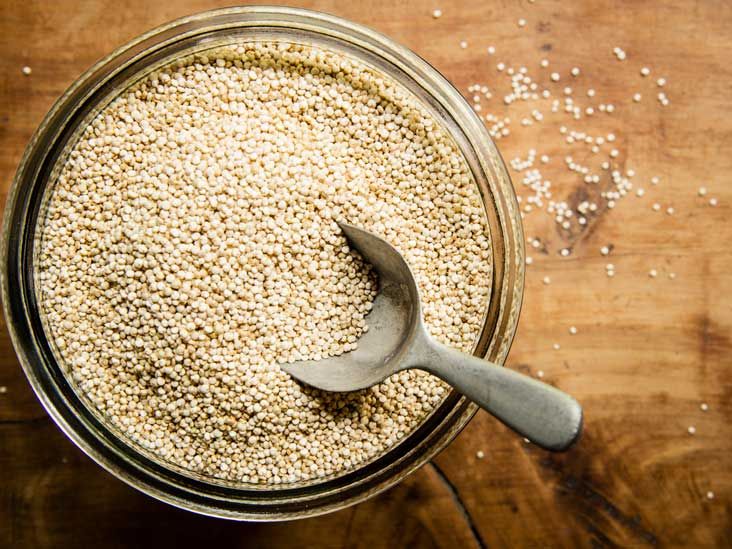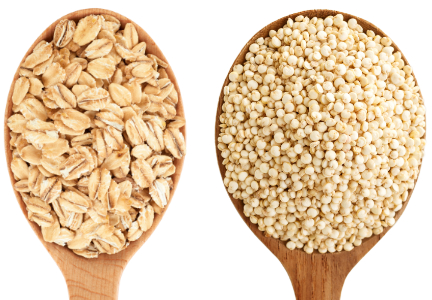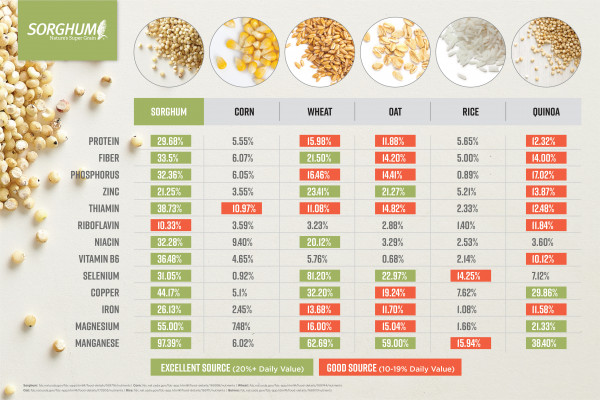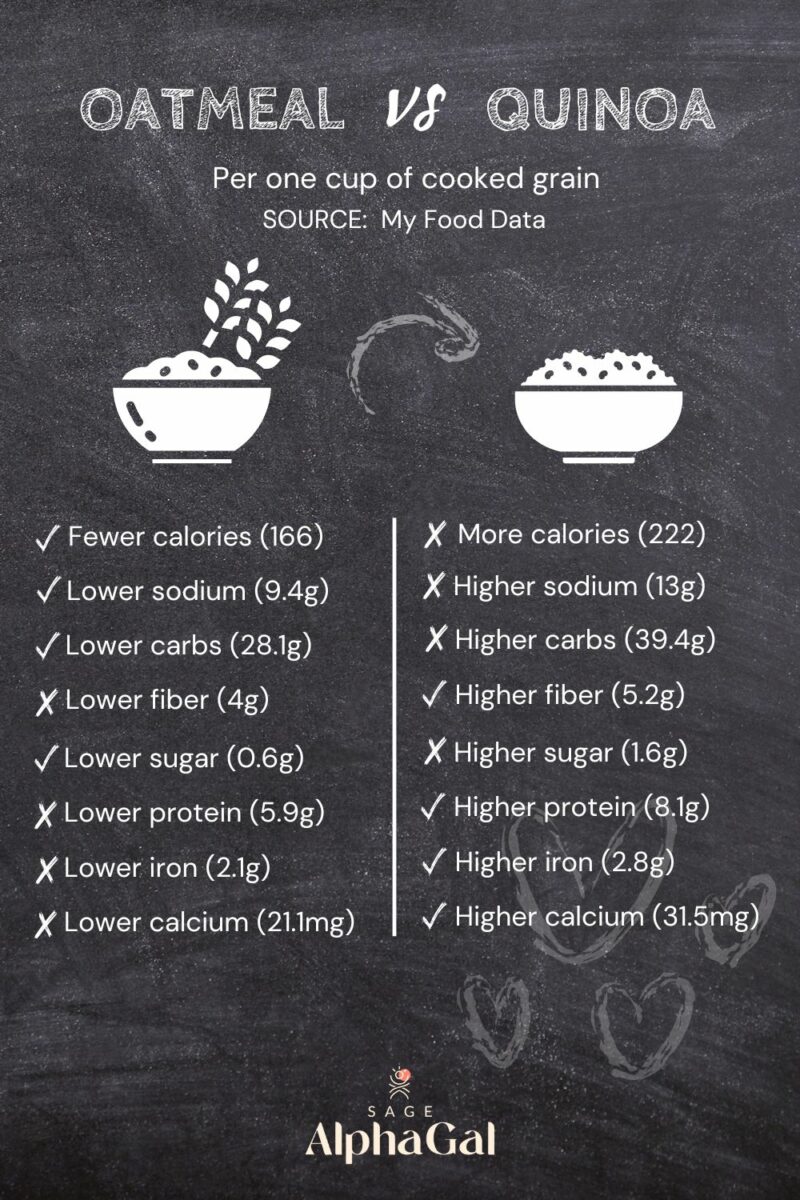Nutritional Value And Health Benefits

When comparing oats and quinoa, both grains have impressive nutritional profiles and offer numerous health benefits. Oats are rich in fiber, providing a feeling of fullness, aiding in digestion, and supporting heart health. They are also a good source of vitamins and minerals, such as manganese, phosphorus, and magnesium. On the other hand, quinoa is a complete protein, containing all essential amino acids, making it a great option for vegetarians and vegans. It is also high in antioxidants, which help fight against inflammation and oxidative stress. Both grains provide various health benefits and can be incorporated into a balanced diet for overall well-being.
1 Oats Nutritional Value And Benefits
Oats are a highly nutritious grain that offers numerous health benefits. They are rich in fiber, which aids in digestion, promotes satiety, and helps regulate blood sugar levels. Oats are also a good source of vitamins and minerals, including manganese, phosphorus, and magnesium. Additionally, oats contain antioxidants, such as avenanthramides, which have anti-inflammatory properties and support heart health. The beta-glucan fiber found in oats can lower cholesterol levels and improve cardiovascular health. Including oats in one’s diet can contribute to overall well-being and provide a delicious and nutritious option for meals and snacks.
2 Quinoa Nutritional Value And Benefits
Quinoa is a highly nutritious grain that offers various health benefits. It is a complete protein, meaning it contains all essential amino acids necessary for the body. Quinoa is also rich in fiber, which aids in digestion and promotes satiety. It is a good source of vitamins and minerals, including magnesium, phosphorus, and manganese. Additionally, quinoa contains antioxidants that help reduce inflammation and support heart health. Incorporating quinoa into one’s diet can provide essential nutrients, contribute to overall well-being, and offer a delicious and versatile grain option.
Cooking And Versatility

When it comes to cooking and versatility, both oats and quinoa offer a wide range of options. Oats can be cooked and used in various ways, such as in overnight oats, oatmeal cookies, or granola bars. They can also be ground into oat flour for baking purposes. On the other hand, quinoa can be cooked and used as a side dish, added to salads, or used as a substitute for rice in pilafs and stir-fries. Its mild flavor makes it a great canvas for different ingredients and flavors. Whether you prefer sweet or savory dishes, both oats and quinoa can be easily incorporated into your meals.
1 Ways To Cook And Use Oats
Oats are incredibly versatile and can be used in various ways in the kitchen. Here are some popular ways to cook and use oats:
- Oatmeal: Cook oats with water or milk for a warm and comforting bowl of oatmeal. Customize it with toppings like fruits, nuts, and honey.
- Overnight oats: Mix oats with milk or yogurt, and let it sit overnight in the fridge. In the morning, you’ll have a delicious and nutritious ready-to-eat breakfast.
- Baked goods: Use oat flour or rolled oats in baking cookies, muffins, bread, and granola bars for added texture and nutrition.
- Oat milk: Blend soaked oats with water, strain, and use the creamy oat milk as a dairy-free alternative in smoothies, coffee, or baking recipes.
The options are endless with oats, allowing you to incorporate them into your favorite recipes and create delicious and healthy meals.
2 Ways To Cook And Use Quinoa
Quinoa offers a range of cooking options, making it a versatile and nutrient-rich grain to incorporate into your meals. Here are two popular ways to cook and use quinoa:
- Quinoa Salad: Cook quinoa according to package instructions and let it cool. Toss the cooked quinoa with diced vegetables, such as cucumbers and tomatoes, and add a dressing of your choice. This refreshing and protein-packed salad can be enjoyed as a light lunch or side dish.
- Quinoa Stir-Fry: Cook quinoa and set it aside. In a separate pan, sauté your favorite vegetables with garlic and ginger. Add the cooked quinoa and a splash of soy sauce or your preferred seasoning. Mix everything together and serve as a nutritious and savory stir-fry.
With these cooking methods, you can easily incorporate quinoa into your diet and enjoy its unique flavor and texture.
Taste And Texture

Quinoa and oatmeal offer distinct tastes and textures that cater to different preferences. Oatmeal has a smooth, creamy consistency that creates a comforting and familiar mouthfeel. It has a milder flavor profile, making it a versatile base for adding various toppings and flavors. On the other hand, quinoa has a delicate, crunchy texture and a slightly nutty flavor, adding a subtle richness to dishes. Its smaller round grains offer a pleasant chewiness, providing a unique eating experience. Whether you prefer the comforting creaminess of oatmeal or the delicate crunch of quinoa, both grains offer delicious options for breakfast or other meals.
1 Oats Taste And Texture
Oats have a smooth and creamy texture that creates a comforting mouthfeel. They have a mild, slightly nutty flavor that pairs well with various toppings and flavors. Whether cooked with water, milk, or plant-based alternatives, oats maintain their soft and velvety consistency. The texture of oats can be customized by adjusting the cooking time and liquid to achieve a desired thickness. Oats can be enjoyed as a warm porridge, overnight oats, or even in baked goods, providing a versatile and satisfying eating experience.
2 Quinoa Taste And Texture
Quinoa has a distinct taste and texture that sets it apart from oats. It has a nuttier flavor compared to oats, adding a subtle earthy and slightly sweet note to dishes. Quinoa’s texture is fluffy and light, with a slight chewiness that provides a satisfying mouthfeel. When cooked, quinoa retains its individuality and doesn’t become mushy, making it a great choice for salads, pilafs, and stir-fries. Its versatility allows it to absorb flavors well, making it a great canvas for various seasonings and ingredients. Quinoa’s unique taste and texture make it a popular choice for those seeking a different grain option.
Sustainability And Environmental Impact

Quinoa cultivation often requires large amounts of water and has faced concerns regarding environmental impacts in some regions. On the other hand, oats have a relatively low environmental footprint and are often grown locally in many regions, reducing food miles and supporting local economies. Growing oats is a relatively low impact crop and beneficial to the environment. Oats are farmed through crop rotations, which halt or improve soil erosion. Additionally, oats require less water than most other grains due to their fibrous roots that retain water from the rain.
1 Sustainability Of Oats
Oats are known for their sustainable cultivation practices, making them a more environmentally friendly option compared to quinoa. Oat farming often involves crop rotations, which help improve soil erosion and promote biodiversity. Additionally, oats require less water compared to other grains, thanks to their fibrous roots that retain water from rainfall. Local production of oats further reduces the carbon footprint by minimizing transportation distances and supporting local economies. Overall, choosing oats over quinoa can contribute to sustainable agriculture and have a lower environmental impact.
2 Sustainability Of Quinoa
Quinoa is considered a relatively sustainable grain due to its ability to thrive in harsh climates and its low water requirements. It is a hardy crop that can grow in diverse environments, making it less reliant on irrigation compared to other grains. Additionally, quinoa cultivation does not typically require the use of chemical fertilizers or pesticides, which helps minimize environmental pollution. However, the increasing demand for quinoa has raised concerns about the social and economic implications for farmers in quinoa-producing regions, as it can lead to issues such as land degradation and loss of biodiversity.
Price And Accessibility

When it comes to price and accessibility, oats are the clear winner. Oats are widely available and much more affordable compared to quinoa. A kilogram of oats can cost around $1.60, while quinoa can cost over $20 per kilogram. The significant price difference makes oats a more accessible option for individuals on a tight budget. Additionally, oats can be found in most grocery stores, making them easily accessible to consumers. On the other hand, quinoa may be harder to find and may only be available in specialty health food stores or online retailers. So, if cost and accessibility are important factors for you, oats would be the more favorable choice.
1 Cost And Availability Of Oats
Cost and Availability of Oats:
When it comes to price and accessibility, oats are the clear winner. Oats are widely available and much more affordable compared to quinoa. A kilogram of oats can cost around $1.60, making it a cost-effective option for individuals on a tight budget. Additionally, oats can be found in most grocery stores, making them easily accessible to consumers. With their lower price point and widespread availability, oats are a practical choice for those looking to incorporate a nutritious grain into their diet without breaking the bank.
2 Cost And Availability Of Quinoa
Quinoa, on the other hand, tends to be much more expensive and may be less readily available compared to oats. A kilogram of quinoa can cost over $20, making it a significantly higher-priced option. Additionally, quinoa may not be as commonly found in regular grocery stores, requiring individuals to seek out specialty health food stores or online retailers. The higher cost and limited availability of quinoa can make it less accessible for individuals on a tight budget or those living in areas without easy access to health food stores.
Conclusion

In conclusion, both oats and quinoa offer unique nutritional benefits and can be incorporated into a healthy diet. Oats are a great source of fiber and have been linked to improved heart health and digestion. Quinoa, on the other hand, is a protein-rich grain that contains essential amino acids. When it comes to cost and accessibility, oats are generally more affordable and readily available compared to quinoa. Ultimately, the choice between oats and quinoa depends on individual preferences and dietary needs. Both grains can be enjoyed in a variety of ways and contribute to a balanced and nutritious diet.
Comparison Between Oats And Quinoa
When comparing oats and quinoa, there are several factors to consider. In terms of nutritional value, both grains offer unique benefits. Oats are rich in fiber and have been linked to improved heart health and digestion. Quinoa, on the other hand, is a protein-rich grain that contains essential amino acids. In terms of taste and texture, oats have a mild and slightly sweet flavor with a soft and chewy texture. Quinoa has a nutty flavor and a slightly crunchy texture. When it comes to price and accessibility, oats are generally more affordable and readily available compared to quinoa. Overall, the choice between oats and quinoa depends on individual preferences and dietary needs. Both grains can be enjoyed in a variety of ways and contribute to a balanced and nutritious diet.
Which Grain Option Is Best For You?
When it comes to choosing between oats and quinoa, the best grain option for you depends on your personal preferences and dietary needs. If you have a gluten allergy, quinoa is the obvious choice as it is completely gluten-free. Additionally, quinoa is a great option for those looking to increase their protein intake and get essential amino acids. On the other hand, if you prefer a grain that is more readily available and affordable, oats would be the better choice. Both grains offer unique nutritional benefits, so it ultimately comes down to what fits best into your lifestyle and health goals.
FAQ About Oats Vs Quinoa: Comparing Grain Options
Q: What are the nutritional differences between oats and quinoa?
A: Oats are high in fiber and contain beta-glucans that help lower cholesterol. Quinoa is a complete protein, rich in amino acids, and is also high in fiber.
Q: Which grain is better for weight loss, oats or quinoa?
A: Both oats and quinoa can aid in weight loss as they are high in fiber and protein, keeping you fuller for longer. Quinoa may provide slightly more protein per serving compared to oats.
Q: Can oats or quinoa be a good gluten-free alternative?
A: Quinoa is naturally gluten-free and can be a great alternative for those with gluten sensitivities. While oats are gluten-free, they are often cross-contaminated with gluten during processing unless certified gluten-free.
Q: Are oats or quinoa better for cooking versatility?
A: Quinoa is versatile and can be used in various dishes, from salads to main courses. Oats are commonly used in breakfast dishes like oatmeal and baking recipes.
Q: Which grain has a higher antioxidant content, oats or quinoa?
A: Quinoa contains a higher amount of antioxidants compared to oats. These antioxidants help in reducing inflammation and promoting overall health.
Q: Is one of these grains more sustainable to grow than the other?
A: Quinoa requires less water to grow compared to oats, making it a more sustainable option in terms of water usage. Oats, however, are more commonly grown in a wider range of climates.

We are introducing OH! NANA, where culinary excellence meets sustainability! Our journey began with a passion for creating delicious, nutrient-dense dishes while minimizing waste and environmental impact. At OH! NANA, we believe that great taste and nutritional value can go hand in hand with responsible sourcing and production. Our commitment to delivering intense flavors and high nutritional value is paired with a dedication to reducing waste in every aspect of our operations. From sourcing fresh, locally-grown ingredients to implementing efficient kitchen practices, we strive to positively impact both your health and the health of our planet.